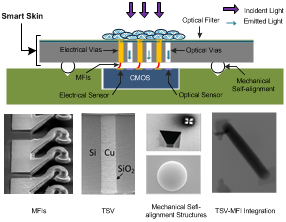Inventors at Georgia Tech have developed a low-cost silicon-based cellular sensing platform, called the 'Smart Petri Chip', which offers the potential for large-scale and high throughput, real-time cellular monitoring, and re-usability with no contamination. The key features of the Smart Petri Chip are: 1) the ability to use either a single or multimodality sensor, 2) a disposable/reusable substrate interface between the sensor and the bio-film which features electrical and photonic conduction paths between the cellular layer and the sensors, and 3) a simple alignment mechanism and flexible interconnects between the interconnect mechanism, the disposable substrate and the sensor layer. This feature greatly enables the easy placement and replacement of the disposable substrate. Moreover, the use of a low-cost substrate to interface between the biological layer and the sensors makes possible a large number of repeatable and controlled measurements. The Smart Petri Chip is composed of a silicon-substrate layer containing electrical and optical vias as well as a disposable layer positioned between the cellular layer and the sensor/signal processing layer. Self-alignment tabs guide and position the substrate layer. Electrically conductive flexible interconnects form an electrical connection between the disposable layer and the sensor layer. A clamp mechanism is used to hold down the disposable layer during testing. Upon test completion, the disposable layer can be easily removed and replaced with a new substrate. The disposable layer serves as a low-cost interface between the biological layer and the sensor and electronics.
- Large-scale throughput, real-time cellular monitoring, and re- usability with no contamination
- Easily and inexpensively replaced
- Modules can be designed for various functions
- The modules may be from different technologies, such as CMOS, MEMS, silicon photonics
- Drug screening
- Labs
Cell-based assay systems have become increasingly important as the pharmaceutical industry seeks to increase the efficiency of drug development. Use of cell-based assays have the potential to help reverse an increasing trend of costly late-stage drug failures, which can result in a loss of several hundred million dollars. Current cell-based systems, especially those relying on a single modality of fluorescent detection, have major limitations such as expensive equipment, limited high throughput capacity, and lack the capacity for continuous and lengthy monitoring.

